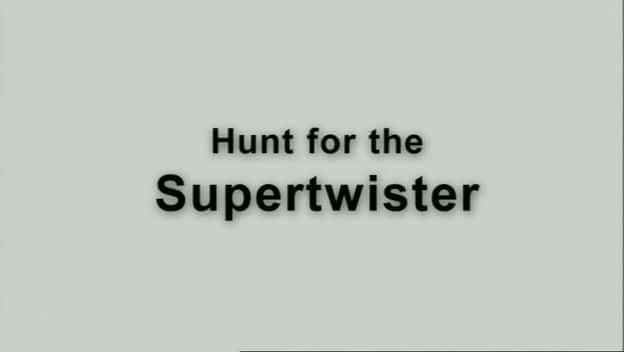|
|
Hunt for the Supertwister - 纪录片1080P/720P/360P高清标清网盘迅雷下载

Hunt for the Supertwister - 纪录片1080P/720P/360P高清标清网盘迅雷下载
Hunt for the Supertwister,Angry Skies,Cloudspotting,Cyclone,Extreme Weather,Hunt for the Supertwister (PBS),Natural Disasters,Nature's Fury,Natures Fury (ITV),Oklahoma's Deadliest Tornadoes,Stormchaser: The Butterfly and the Tornado
General Information:
Nature Documentary hosted by Dilly Barlow and published by BBC broadcasted as part of BBC Horizon series in 2004- English narration
Information
On 3 May 2003 a tornado smashed through two suburbs of Oklahoma City. It had struck at the height of the tornado season, yet residents were still shocked by the destruction it wrought. Eight thousand homes were destroyed, a billion dollars of damage was wreaked and 40 people lost their lives. What had hit Oklahoma City that day was not just any old tornado - it was a super-twister.
Tornadoes are classified on the Fujita scale, or F-scale. Most tornadoes that occur around the world can be classified on the lower reaches of the scale - the F0s, F1s or F2s. These can still cause damage and have winds in excess of 160km/h.
Supertwisters are an altogether different beast. Terrifying and destructive, at their most extreme they are powered by wind travelling in excess of 480km/h. This is strong enough to lift strong framed houses from their foundations and seriously damage even reinforced concrete.
Every year hundreds of people around the world are killed or injured by supertwisters. Yet what makes them even more terrifying is that it is practically impossible to predict their appearance or movement. Why they form in the first place remains a mystery.
The mystery of supertwisters
Most US tornadoes occur in Tornado Alley, a flat mid-western stretch from Texas in the south to the Dakotas in the north. High season for supertwisters tends to be during spring, from March to June.
Tornadoes usually appear during a thunderstorm. Supertwisters are associated with super-cells, the largest thunderclouds of all. These are enormous rotating columns of air that can be over 30km across and 18,000 metres high - twice the height of Mount Everest.
All tornadoes form when warm, moist air is pushed upward by a mass of cold air. This creates an updraft within the stormcloud that can cause a large mass of circulating air. When this air comes in contact with the ground it becomes a tornado. What is not known is precisely what triggers this final stage to form a tornado...
The hunters
A group of scientists are trying to plug these gaps in our knowledge. These 'storm chasers' take their lives in their own hands every time they go out in the field. To get the crucial data they need to get close to the supertwisters. Their research is vital to finding a way of giving people a few extra minutes warning. The time might not be enough to save houses or possessions, but could save lives.
To help them, they use the very latest technology. Many of them, like Howie Bluestein from the University of Oklahoma, track storms using a Doppler radar dish mounted on the back of a truck. Doppler radar uses sound waves to sense the movement of air and moisture in remarkable detail - it is the most accurate way of mapping the swirling wind patterns that make up a tornado. Many storm chasing teams use at least two of these trucks so they can record information on the storm from different angles. But even with all the latest equipment, storm chasers consider themselves lucky if they intercept one or two tornadoes each year.
How to use the data
Gathering the data is one thing, working out what to do with it is another problem altogether. Much of the work uses specially designed computer models. Lou Wicker and his colleagues from the University of Illinois have spent the past decade developing state-of-the-art software that will help to explain precisely how a tornado forms. Some of his latest work involves working out how to visualise a storm using real tornado data, picked up from the storm chaser's Doppler radar.
He added the real wind speeds, atmospheric pressure and humidity present before a storm into his model. Could this model use the data to make an artificial tornado within his computer? If possible, he should be able to observe the inner workings of the twister and therefore see what had triggered the final touch down.
Wicker and his colleagues soon noticed something crucial - the simulation showed a clear hook of wind and a strong downdraft. His model also showed that just as the storm was intensifying a series of whirlwinds were forming at ground level. These tiny corkscrews of wind merged together into a much larger current and seemed to form the tornado itself.
The whirlwinds which showed up in the computer were so subtle that in reality they would be invisible to the naked eye. What seemed to make Wicker's work so exciting was that these mini-whirlwinds had shown up on real tornadoes picked up by both Bluestein's and fellow supertwister expert Dr Josh Wurman's radar. Could identifying these tiny whirlwinds in advance be the key to finding the extra time in tornado prediction?
Technical Specs
Size: 560 MB
Duration: 00:48:48
Resolution: 624 x 352
Video codec: Xvid
Audio codec: MP3
Audio Bitrate: 149 Kbps
☆☆☆~~~~~~~~~~~~~~~~~~~~~~~~~~~
Hunt for the Supertwister - 纪录片1080P/720P/360P高清标清网盘迅雷下载
下载地址:
游客 文件下载链接就在这里,在您回复评论成功后才能显示。
请勿回复无意义的灌水内容。下拉页面到最底部回复或者 【点击此处快捷回复】,回复后返回此处即可查看下载链接。 如您没注册本站会员,可以点击 注册本站,注册后即可回复下载。 |
小贴士:【影视自媒体解说文案请移步:夏至文案解说网 www.xiazhi.vip】上一篇:The Hunt for Escobar's Hippos - 纪录片1080P/720P/360P高清标清网盘迅雷下载下一篇:Hunt for the Supertwister (PBS) - 纪录片1080P/720P/360P高清标清网盘迅雷下载
|